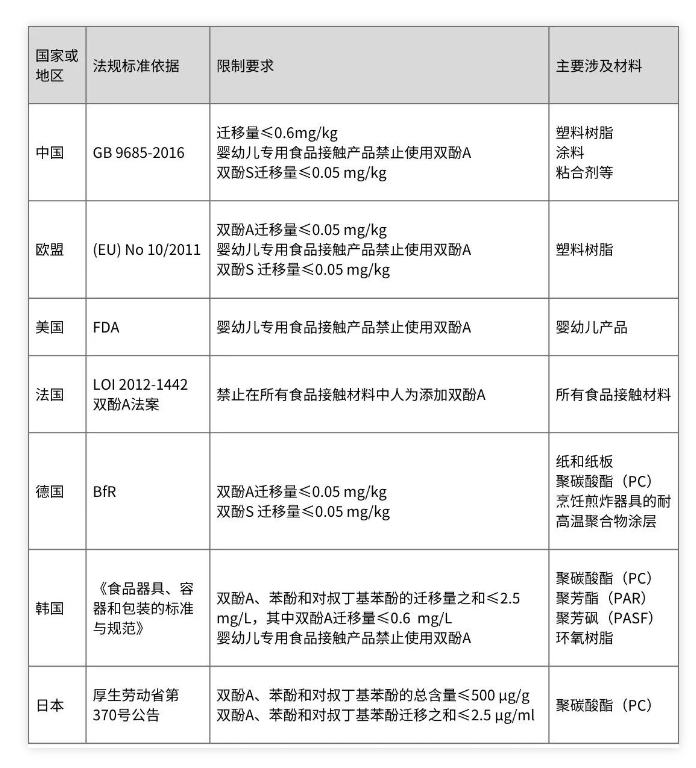On July 18, 2023, the EU Food and Health Directorate (DG Sante) held a webinar, in which it stated that it intends to ban the intentional addition of bisphenol A and its analogs in food contact materials.

Bisphenols have been widely concerned due to health risks. On April 19 this year, the European Food Safety Authority (EFSA) issued a scientific opinion to re-evaluate bisphenol A (BPA), based on the assessment of the increase in the percentage of Th17 cells in mice , to determine the tolerable daily intake of BPA
(TDI) is 0.2 ng/kg bw/d, and the SML calculated according to this TDI is far lower than the level that can be achieved by the current analytical method.
In view of this result, EFSA believes that the authorized use of BPA in food contact materials is no longer reasonable, and the intentional use of bisphenol A in food contact materials should be prohibited, not only limited to plastics, but also varnishes, coatings, inks, adhesives, rubber, etc.
Many substances similar in structure to BPA, such as bisphenol S, bisphenol F, bisphenol AF, bisphenol fluorene, etc., have been developed as substitutes for BPA, but further toxicological studies have found that they may have the same effect as BPA.
Similar metabolism, potency and actions, resulting in similar potential health hazards as BPA. In order to maximize consumer safety, the CLP Regulations (Classification, Labeling and Packaging Regulations for Substances and Mixtures) include bisphenol S
, 2,2-bis(4′-hydroxyphenyl)-4-methylpentane is classified as reproductive toxicity category 1B substances.
DG Sante expects the ban to come into effect in the spring of 2024, after an 18-month transition period, expected in late 2025 or 2026
At the beginning of the year, food contact materials containing the above-mentioned bisphenols will be banned from entering the market. It is difficult to rule out the use of bisphenols in a short time, such as some acidic foods with coated metal packaging, the industry can do so on September 15, 2023
Apply to DG Sante for an extension of the transition period before the date.
License and Usage
At present, BPA and its similar substances are mainly used in the production of plastics such as polycarbonate and polyethersulfone. BPA is also widely used in the manufacture of epoxy resins for food and beverage can lining coatings, metal caps and bottle caps, and some of the food industry. Large storage tanks.
The EU Plastics Regulation (EU) 10/2011 authorizes BPA as a monomer of plastics, and the SML is 0.05mg/kg. The same SML is also suitable for food contact varnishes and coatings. Since 2018, the use of BPA is prohibited in special food contact materials for infants and young children. The restrictions on BPA and similar substances in different countries are as follows:

development of alternative technologies
DG
Sante believes that: in terms of safe alternatives, there is no major problem in the production of plastics such as synthetic polycarbonate and polysulfone plastics; there is no technical obstacle to the production of other food contact materials such as rubber and adhesive paper; Varnishes and coatings need to consider the impact on expectations, such as cost, shelf life of some products, energy consumption, etc. The transition to all food products on the EU market will take some time.
Tetramethylbisphenol F (TMBPF, CAS
5384-21-4) was considered a safe substitute for BPA in epoxy coatings, but follow-up studies have shown that TMBPF may also have antiestrogenic and antiandrogenic activities in vitro, which is also a problem faced by many BPA substitutes. Scientists have developed alternative products derived from natural materials such as bisguaiacol-F derived from lignin
(BGF) [1], bio-based phenyl-furan-phenyl derivatives (PFP ) [2], modified curcumin [3], isosorbide, etc. Due to the high production cost and limited range of applications, it has not been commercialized on a large scale.
Introduction to IQTC related research and testing capabilities
IQTC is committed to the research on the detection method of bisphenol A and other similar substances in food contact materials [4], and can detect bisphenol A in food contact materials and products according to GB 31604.10-2016
Migration, and developed the ability to detect a total of 17 bisphenols including bisphenol F, bisphenol S, etc.
IQTC has also developed an internal detection method for the residues of bisphenol A, bisphenol S and bisphenol F in paper products and plastic products, and the detection limit is as low as 0.05mg/kg. For samples with complex matrices such as chemicals and raw materials, the detection limit of residues can generally be 1
mg/kg.




 微信扫一扫打赏
微信扫一扫打赏
